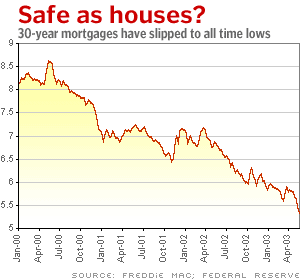NEW YORK (CNN/Money) -
Think you missed out on the limbo contest in interest rates? It may keep going on longer than you think.
Ever since the Federal Open Market Committee met two weeks ago, fixed-income markets have put on a stunner of a rally. Heavy buying of Treasurys has dropped the yield on the 10-year note more than a half-percentage point to a stunningly low 3.34 percent. Corporate bonds have also seen yields drop by a half-percentage point, and the average rate on a conventional 30-year mortgage has slipped to an all-time low of 5.34 percent, according to the Freddie Mac.
"The whole game has changed," said D.A. Davidson bond trader Mary Ann Hurley. "A year ago there's no way I would have thought rates would be this low. Now I think the 10-year yield could easily fall down to 3 percent."
Same time next year
The reason? When the Fed said two weeks ago it was more worried about a further fall in inflation than a rise, market participants took it to mean the bank will keep a lid on interest rates until it sees a meaningful pickup in inflation.

And since inflation doesn't tend to heat up until after a half-year or so of good economic growth, the Fed was basically saying that it wouldn't raise rates for a good long time. Investors in the fed funds futures market, who trade off of their expectations for Fed moves, think that this time next year the Fed's target rate will be at the current 1.25 percent.
In other words, it was almost as if Alan Greenspan and his cronies stood out on the steps of the Marriner S. Eccles Federal Reserve Board Building handing out crisp new peachbacks. When financial institutions believe the Fed will keep the overnight borrowing rate at 1.25 percent well into next year, they feel much more comfortable taking their money and putting it into longer-term debt.
As Treasury rates fall, financial institutions and fixed-income investors, anxious to boost returns, may continue to plough money into higher yielding assets, like corporate bonds and mortgages. And because they know (or think they know) the Fed isn't going to raise rates, those assets don't look nearly as risky as they did just a few weeks ago.
"When fixed-income investors conclude that the central bank isn't going to raise rates any time soon," said Prudential Securities chief investment strategist Ed Yardeni, "there tends to be a convergence of rates."
Checks for free
For the struggling U.S. economy, the sharp move down in long term rates could be a very good thing. Lower rates, for example, have already spurred a fresh surge in refinance activity, allowing households to lower mortgage payments and pay down debt -- as well as putting extra money into people's pockets.
"Lower rates are going to help keep the consumer going, and that's a big plus" said Raymond James economist Scott Brown. With businesses still tightfisted, consumer spending has been the main thing keeping the economy dragging along. The bump up in mortgage activity buys a little more time for the economy while businesses try to get their acts together.
Meanwhile, the drop in corporate bond rates makes things easier for businesses, too.
"This is a positive for corporate balance sheets," said Hurley. "They're able to restructure higher-yielding debt for debt at levels that we haven't seen in 45 years."

In so doing, companies can radically reduce interest payments or, as has lately been the case, keep on paying the same amount but be clear of their debt sooner.
"Once they get that debt paid off, it's just free cash flow," said Bank One chief economist Diane Swonk.
They can then turn around and spend that money on something else, like boosting their labor force, or buying new equipment. Just the sort of thing the economy needs to get back on the path to growth.
But there may be an eventual downside to this, points out Prudential's Yardeni. One of the things that recessions do, or should do, is cut away economic excesses. Businesses that shouldn't exist fall by the wayside, paving the way toward a reallocation of resources into the areas of the economy most likely to propel future growth.
"The best way to set the stage for a sustainably strong recovery is to liquidate the weak hands," said Yardeni. "Bringing interest rates lower and lower has probably allowed a lot of borrowers, who should have gone under, to stay in business." In the end, that could mean that too many sellers are chasing after too few buyers -- just the sort of situation that can give rise to (gasp) deflation.
The more immediately worrisome scenario, however, is one where fixed-income investors become so fretful over the potential for economic weakness that they decide that, even with the Fed's promise to be accommodative, extending credit to companies and households is simply too risky.
"You don't want this rally to be cut short before we get back on solid economic ground," said Swonk.

|

